The Importance of E-commerce Website Design in the Digital Age

In today’s world, where geographical boundaries for commerce have faded, #ecommerce_website_design is no longer a luxury choice, but a vital necessity for any business.
This action allows businesses to operate beyond spatial and temporal limitations and offer their products and services to customers worldwide.
Creating an online store is not just a new storefront for your business; it opens a gateway to boundless markets and unlimited income potential. With the ever-increasing spread of the internet and the growing habit of online shopping among people, the lack of an active presence in the digital space can mean losing a significant market share.
Today’s consumers seek convenience, variety, and speed in shopping, and physical stores alone cannot meet all these needs.
A professional e-commerce website not only showcases your products but also builds customer credibility and trust.
This digital platform allows you to provide complete product information, collect customer reviews, and offer a personalized experience for each user. This investment will ultimately lead to sustainable growth and increased profitability for your business.
In fact, e-commerce is rapidly becoming the backbone of the global economy, and businesses that fall behind will lose their chance to compete.
Therefore, the importance of e-commerce website design is more evident than ever for long-term success in the modern business landscape.
Are you frustrated with the low conversion rate of your online store?
Rasawb, with professional e-commerce website design, is your definitive solution!
✅ Increase your sales and revenue
✅ Unparalleled user experience for your customers
⚡ Get a free consultation now!
Choosing the Right Platform for Your Online Store
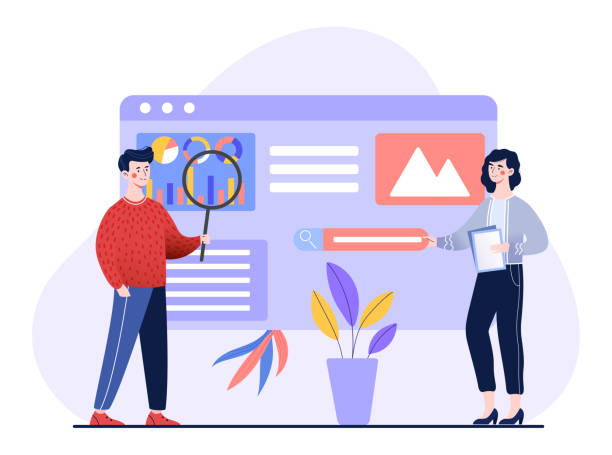
After understanding the importance of an online presence, the next crucial step in e-commerce website design is choosing the right platform.
This decision directly impacts the future capabilities, costs, ease of management, and scalability of your store.
Various platforms are available in the market, each with its own advantages and disadvantages.
For example, ready-made and SaaS (Software as a Service) platforms like Shopify, BigCommerce, and Squarespace are popular choices for small and medium-sized businesses due to their ease of setup and lack of deep technical knowledge required.
These platforms typically include hosting, SSL certificates, and technical support, but in return, they offer less flexibility in customization, and you are required to pay a monthly subscription.
On the other hand, open-source platforms like WooCommerce (for WordPress) and Magento offer unparalleled flexibility in customization and development.
These options are more suitable for larger businesses with specific needs and high scalability, but they require more technical knowledge for setup, management, and maintenance. Also, hosting, development, and support costs will be your responsibility.
The choice of the right platform should be based on factors such as your budget, product volume, technical requirements, expected capabilities, and future growth plans.
Are you looking for a quick and hassle-free solution, or do you intend to create a fully customized store with complex functionalities? Answering these questions will help you select the best platform for building your online store.
Consulting with e-commerce website design specialists at this stage can be very helpful.
Key Steps in Successful E-commerce Website Design
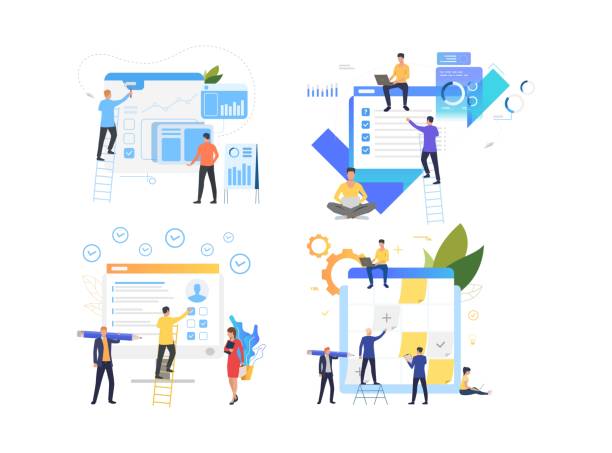
To achieve successful e-commerce website design, following a systematic, step-by-step approach is essential.
These stages include meticulous planning, attractive visual design, technical development, comprehensive testing, and proper launch.
The first step is the planning phase, where business goals, target audience, products and services, and required budget are defined. In this phase, keyword research and competitor analysis are also highly important.
After that, we move to the UI/UX design phase, where site maps, wireframes, and prototypes are designed to provide the best user experience.
This section ensures that your site is not only visually appealing but also functional and easy to navigate.
The next stage is technical development, which involves coding (if custom solutions are needed) or configuring the chosen platform, integrating payment gateways, inventory management systems, and other essential plugins.
Security is of paramount importance at this stage, especially concerning payment information and user privacy. After development, the comprehensive testing phase begins.
In this stage, all functionalities, links, payment gateways, and compatibility with various devices (mobile, tablet, desktop) are checked to ensure the flawless performance of the site.
Finally, after resolving all issues, your e-commerce website will be ready for public launch.
This phased process not only guarantees the efficiency of the site but also maximizes its potential for attracting and retaining customers.
A strong e-commerce website design provides a solid foundation for success in today’s competitive world.
| Feature | WooCommerce (WordPress) | Shopify | Magento |
|---|---|---|---|
| Platform Type | Open-source (WordPress Plugin) | SaaS (Software as a Service) | Open-source (Standalone) |
| Ease of Use | Medium to Easy | Very Easy | Difficult (Requires Expertise) |
| Initial Cost | Hosting and Domain (Low) | Monthly Subscription (Medium) | Hosting, Domain and Development (High) |
| Customization Capability | High | Medium (Limited to Themes and Apps) | Very High |
| Technical Support | Community and Developers | 24/7 (In-house Team) | Community and Developers |
| Scalability | Medium to High | High | Very High (Suitable for Large Organizations) |
User Interface (UI) and User Experience (UX) in Online Stores
![]()
The success of an e-commerce website design heavily depends on the quality of its User Interface (UI) and User Experience (UX).
UI refers to the look and feel of the website (colors, fonts, layout), while UX focuses on the ease of use and the users’ enjoyment when interacting with the site.
An attractive and modern UI design can make a positive first impression on the customer and encourage them to stay on the site. But this is just the beginning; an excellent UX is what guides the customer towards a purchase and converts them into a loyal customer.
Key UX elements in an online store include easy and intuitive navigation, product pages with complete information and high-quality images, a simple and fast checkout process, and full mobile compatibility (responsiveness).
If a customer cannot easily find the desired product, get enough information about it, or if the checkout process is complicated, they will quickly leave the site.
Mobile optimization is more crucial than ever today, as a significant portion of purchases are made via smartphones.
A responsive site ensures that your store displays correctly on any device and provides a consistent user experience.
Furthermore, site loading speed and smooth performance are also important UX factors. Today’s users are impatient, and a slow site can quickly lead to customer loss.
Additionally, providing space for customer reviews and ratings, robust search functionality, and advanced product filters all contribute to improving the user experience.
Ultimately, focusing on UI and UX in e-commerce website design not only leads to increased conversion rates but also builds a strong and memorable brand in customers’ minds.
Is your company’s website as professional and trustworthy as it should be? With specialized corporate website design by Rasawb, create an online presence that represents your credibility and attracts more customers.
✅ Build a powerful and professional image for your brand
✅ Convert visitors into real customers
⚡ Get a free consultation now!
SEO and Optimization for Search Engine Visibility
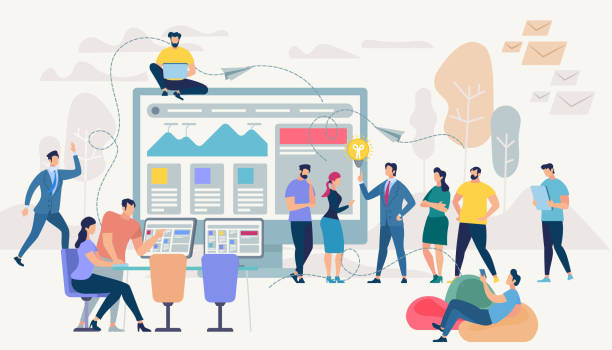
After completing your e-commerce website design, the most important step for attracting traffic and sales is Search Engine Optimization (SEO).
Without SEO, even the most beautiful and user-friendly online store may get lost among countless other websites and be difficult for potential customers to discover.
SEO is essentially the process of improving your site’s ranking in organic search results on Google and other search engines, so that when users search for keywords related to your products, your website appears at the top of the results.
This means free and targeted traffic that has a higher conversion rate.
SEO for online stores includes two main parts: On-page SEO and Off-page SEO. On-page SEO involves optimizing elements within the site such as using appropriate keywords in page titles, meta descriptions, product content, and image descriptions.
Page loading speed, responsive design, friendly URL structure, and creating high-quality and unique content (like blogs and educational articles) are also important factors for on-page SEO.
For example, each product page should have a unique title and complete, engaging descriptions that include keywords relevant to the product.
Off-page SEO primarily involves building quality backlinks from other reputable sites to your store.
These links signal to search engines that your site has credibility and valuable content.
Content marketing, social media activity, and strong public relations can also help improve off-page SEO.
Integrating a strong SEO strategy into the online store creation process from the very beginning is key to success in being seen and attracting customers. Without investing in SEO, your efforts in e-commerce website design may not bear fruit.
Security and Payment Protocols in E-commerce Website Design
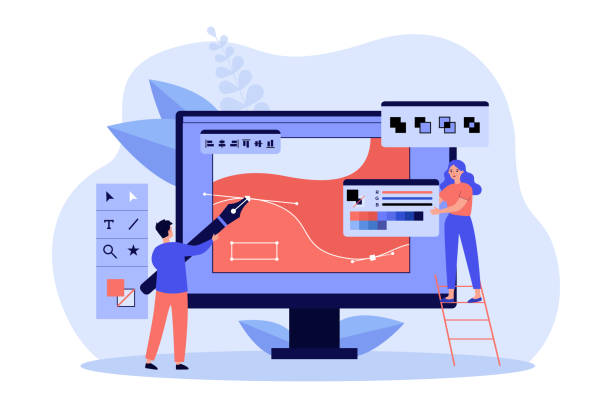
In the online world, customer trust is paramount, and security is the backbone of this trust.
In e-commerce website design, ensuring the security of user information, especially their financial and banking details, is of vital importance.
A security breach can not only lead to the loss of customer data but also irrevocably damage your business’s reputation and credibility.
The first step in ensuring security is using an SSL (Secure Sockets Layer) certificate. This certificate encrypts the information transmitted between the user’s browser and the website server, preventing eavesdropping or tampering by third parties.
The presence of a green padlock next to the website address and “https://” at the beginning of the URL indicates that SSL is active and the connection is secure.
The next step is choosing and integrating secure and reputable payment gateways.
Payment gateways must comply with high security standards (such as PCI DSS) and use strong encryption to protect customers’ credit card information.
Offering diverse and well-known payment options (such as online payment, card-to-card transfer, cash on delivery) can also help increase customer trust.
Additionally, it is necessary to protect your website against common cyber attacks such as DDoS, SQL injection, and XSS. Regular updates of the platform and plugins, use of a Web Application Firewall (WAF), and implementation of strong password policies all contribute to increased security.
It is also recommended not to store sensitive customer credit card information on your servers and to use third-party payment services that assume responsibility for the security of financial data.
Ensuring security in an online store is not only a legal requirement but also a significant competitive advantage in attracting and retaining customers.
Marketing and Advertising After Launching an Online Store
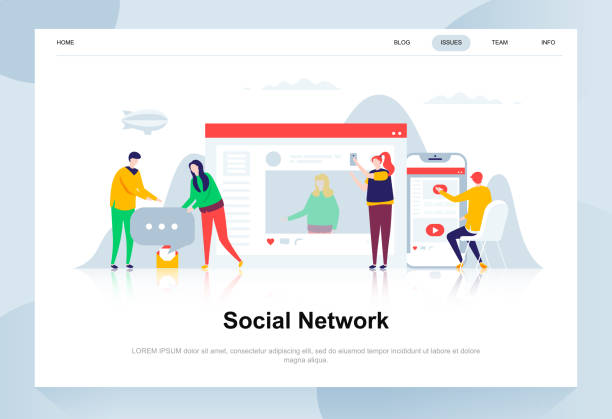
Simply having a flawless e-commerce website design does not guarantee success.
After launch, the crucial stage of marketing and advertising begins to direct potential customers towards your store.
This stage includes various strategies to increase brand awareness, attract traffic, and ultimately boost sales.
One of the most powerful tools is content marketing. Creating valuable content relevant to your products, such as blog articles, buying guides, videos, and infographics, can attract organic traffic and establish you as an authority in your industry.
Email marketing is also a highly effective method for maintaining communication with current customers and re-engaging lost ones.
Collecting emails through newsletter subscriptions or the purchasing process, and sending targeted emails including discounts, new products, and exclusive content, can lead to increased conversion rates.
Activity on social media is also essential for any online store.
An active presence on platforms like Instagram, Telegram, Facebook, and LinkedIn allows for direct communication with customers, building a community of loyal followers, and product introductions.
Paid advertising campaigns on Google (Google Ads) and social media can also drive targeted and quick traffic to your site, especially for new or seasonal products.
Collaborating with influencers, running discount campaigns and contests, and providing excellent customer service after sales all help strengthen marketing and create a positive customer experience.
Continuity and diversity in marketing strategies are key to the long-term success of an e-commerce website.
| Metric | Description | Goal |
|---|---|---|
| Conversion Rate | Percentage of visitors who make a purchase. | Increase |
| Average Order Value (AOV) | Average amount of each order. | Increase |
| Customer Acquisition Cost (CAC) | Total cost to acquire a new customer. | Decrease |
| Customer Lifetime Value (LTV) | Net profit earned from a customer over the duration of the relationship. | Increase |
| Cart Abandonment Rate | Percentage of customers who leave the shopping cart without completing the purchase. | Decrease |
| Website Traffic | Number of visitors to the store. | Increase |
Ongoing Support and Updates for an Online Store
![]()
Successfully launching an e-commerce website design is not the end of the journey, but the beginning of a new chapter that requires continuous support and updates.
Web technology is constantly changing and evolving, and to maintain the security, performance, and competitiveness of your online store, you must always keep it updated.
Lack of regular updates can lead to security vulnerabilities, decreased site speed, compatibility issues with new browsers, and ultimately, customer loss.
Support includes troubleshooting technical issues, responding to customer inquiries, managing orders and product inventory, and providing after-sales service. A strong support system not only helps resolve problems but also increases customer satisfaction and loyalty.
Updates can include security updates, platform updates (like WordPress or WooCommerce), plugin and theme updates, and the addition of new features.
These updates often involve performance improvements, bug fixes, and enhanced user experience.
In addition to technical updates, the store’s content must also be continuously updated.
Adding new products, updating old product descriptions, publishing fresh content on the blog, and updating prices and discounts all help maintain the freshness and appeal of the site and signal to search engines that your site is active and dynamic.
Investing in ongoing support and maintenance services is an essential component of the long-term strategy for any online store. This ensures that your site remains at its peak performance and provides a flawless shopping experience for your customers.
Worried about losing customers because you don’t have a professional e-commerce website?
With e-commerce website design by Rasawb, forget these worries!
✅ Significant increase in sales and conversion rate from visitor to customer
✅ Professional and user-friendly design that builds customer trust
⚡ Get a free consultation from Rasawb now
Common Challenges and Solutions in E-commerce Store Design and Management
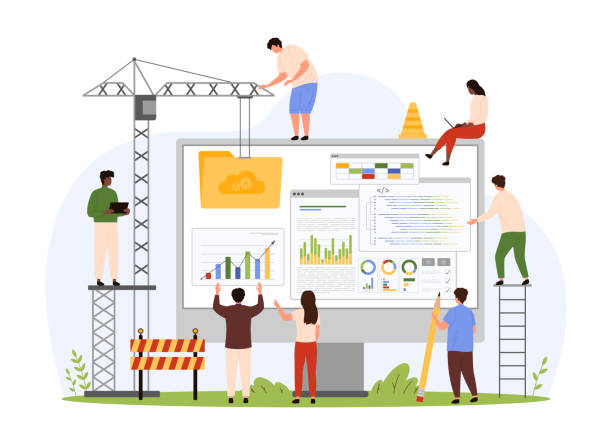
Despite unique opportunities, e-commerce website design and its management are not without challenges.
Understanding these obstacles and being prepared to confront them is key to success in this competitive arena.
One common challenge is intense competition in the online market. Thousands of stores exist in every industry, making it difficult to stand out.
The solution is to focus on a specific niche market, offer unique products, or provide special services that competitors do not.
Another challenge is attracting quality traffic.
Simply having a website does not guarantee traffic.
The solution is to implement a comprehensive SEO strategy, use targeted paid advertising, maintain consistent social media activity, and leverage content marketing.
Inventory and logistics management can also be complex, especially for businesses with high order volumes.
Automating inventory management processes, using advanced warehousing systems, and collaborating with reputable shipping companies can mitigate this challenge.
Cybersecurity and protecting customer information, as mentioned before, are perpetual challenges.
Investing in SSL certificates, using secure payment gateways, and continuous security updates are essential to counter these threats.
One another challenge is the high shopping cart abandonment rate.
Customers may add products to their cart but not complete the purchase.
Solutions such as offering special discounts, a simple and transparent checkout process, sending cart reminder emails, and providing diverse payment options, can reduce this rate.
Customer support can also be a challenge, especially during peak hours or for responding to international customers. Implementing online chat systems, comprehensive Frequently Asked Questions (FAQ), and offering multi-language support can help solve this problem.
Ultimately, understanding and embracing these challenges and finding creative solutions for them are an integral part of successfully managing an online store.
The Future of E-commerce Website Design and Emerging Trends
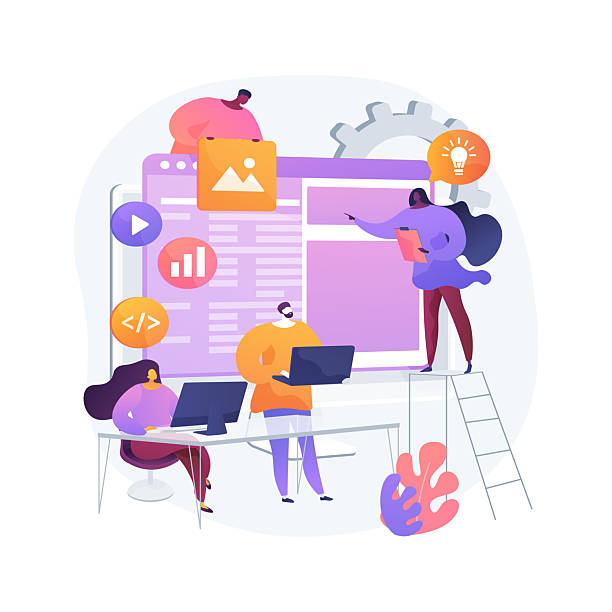
The world of e-commerce website design is constantly evolving, and awareness of emerging trends is essential to maintain competitiveness.
Artificial Intelligence (AI) and Machine Learning (ML) are playing an increasing role in personalizing the shopping experience.
AI-powered product recommendation systems, chatbots that answer customer questions, and predictive analysis of customer behavior all contribute to improved interaction and increased sales.
Augmented Reality (AR) and Virtual Reality (VR) are also changing how customers interact with products. For example, customers can use AR to visualize furniture in their homes or virtually try on clothes.
These technologies can significantly boost conversion rates and provide an unprecedented shopping experience.
Voice Commerce is also becoming an important shopping channel with the proliferation of voice assistants like Siri and Alexa.
Optimizing your store for voice search and ensuring your products are easily discoverable and orderable via voice commands will become increasingly important.
Sustainability and corporate social responsibility have also become important factors in customers’ purchasing decisions.
Stores that prioritize environmental and social issues and reflect these values in their design and operations can gain customer loyalty.
Furthermore, subscription models and local marketplaces are expected to grow further.
Stores that offer subscription services for their products or focus on supplying products to local customers can gain a competitive advantage.
Ultimately, the future of e-commerce websites is one of deeper personalization, more interactive experiences, and greater sustainability.
Those who consider these trends in their e-commerce website design will be pioneers in this industry.
Frequently Asked Questions
| Question | Answer |
|---|---|
| What is e-commerce website design? | It is the process of creating an online platform for selling products or services, which includes user interface (UI) design, user experience (UX), and the necessary functionalities for online purchasing. |
| What are the key features of a good e-commerce website? | Easy navigation, fast loading speed, robust search capability, efficient shopping cart, secure payment gateway, clear product display with high-quality images, user review display, and responsiveness (mobile compatibility). |
| Which platforms are common for e-commerce website design? | Popular platforms include WooCommerce (on WordPress), Shopify, Magento, PrestaShop, as well as proprietary content management systems. |
| What is the importance of a responsive e-commerce site? | Given the increasing use of mobile for online shopping, a responsive site (correct display on different screen sizes) is crucial for providing a good user experience and increasing conversion rates. |
| How long does the process of designing an e-commerce website usually take? | The duration depends on the project’s complexity, number of products, required special features, and implementation method, and can vary from a few weeks to several months. |
And other services of Rasawb Advertising Agency in the field of advertising:
Smart UI/UX: Revolutionize SEO ranking improvement with marketing automation.
Smart Google Ads: A dedicated service for growth in website traffic based on real data utilization.
Smart Advertising Campaign: Professional optimization for customer acquisition using key page optimization.
Smart UI/UX: A novel service for increasing customer acquisition through SEO-driven content strategy.
Smart Data Analysis: A professional solution for increasing sales by focusing on user experience customization.
And over hundreds of other services in the field of internet advertising, advertising consulting, and organizational solutions.
Internet Advertising | Advertising Strategy | Advertorials
Sources
Principles of E-commerce Website DesignSuccess in E-commerceComprehensive Website GuideOnline Store Optimization
? To elevate your business in the digital world, Rasawb Afarin Digital Marketing Agency, specializing in secure website design and SEO, offers innovative and effective solutions.
📍 Tehran, Mirdamad Street, next to Bank Markazi, Southern Kazeroon Alley, Ramin Alley, No. 6
